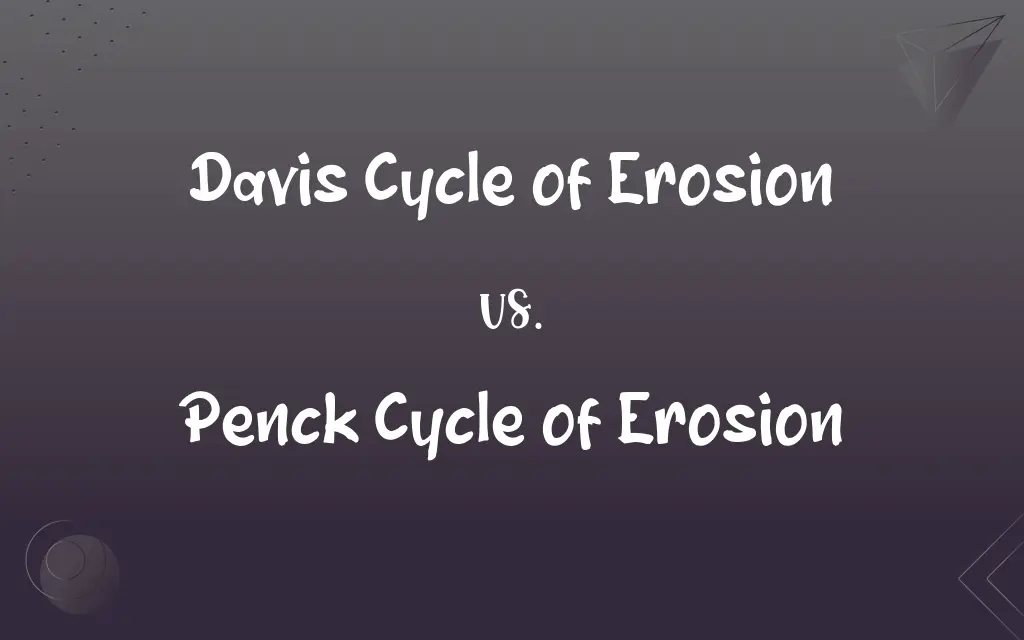Davis Cycle of Erosion vs. Penck Cycle of Erosion: What's the Difference?
Edited by Aimie Carlson || By Harlon Moss || Published on April 28, 2024
The Davis cycle of erosion describes landscape evolution through stages of youth, maturity, and old age, while the Penck cycle focuses on the balance between uplift and erosion rates.

Key Differences
The Davis cycle of erosion is a model that explains the evolution of landscapes through stages of youth, maturity, and old age, with an emphasis on the dominance of downward erosion. The Penck cycle of erosion, on the other hand, focuses on the balance between uplift and erosion rates, proposing that landscapes evolve through parallel slope retreat.
In the Davis cycle, landscapes start with high elevations and steep slopes, gradually becoming more gentle and low-lying over time. The Penck cycle suggests that landscapes maintain a constant angle of slope as they are uplifted and eroded at the same rate, leading to a different pattern of landscape evolution.
The Davis cycle emphasizes the role of time in landscape development, with each stage having distinct characteristics. The Penck cycle, however, does not delineate stages based on time but rather on the continuous interplay between uplift and erosion.
According to the Davis cycle, rivers play a crucial role in shaping the landscape, with the development of valleys and meanders over time. The Penck cycle, however, views the entire landscape as evolving uniformly, with less emphasis on the role of individual rivers.
The Davis cycle of erosion has been widely used in geomorphology for its simplicity and descriptive power, despite some criticisms regarding its applicability to all landscapes. The Penck cycle offers an alternative perspective, emphasizing the importance of tectonic forces and the dynamic balance between uplift and erosion.
ADVERTISEMENT
Comparison Chart
Focus
Stages of landscape evolution (youth, maturity, old age)
Balance between uplift and erosion rates
Key Process
Downward erosion
Parallel slope retreat
Landscape Development
Gradual transition from steep to gentle slopes
Constant slope angle with continuous uplift and erosion
Role of Time
Distinct stages based on time
Continuous process without distinct time stages
Emphasis
Role of rivers in shaping landscapes
Importance of tectonic forces and uniform landscape evolution
ADVERTISEMENT
Davis Cycle of Erosion and Penck Cycle of Erosion Definitions
Davis Cycle of Erosion
A theory that explains the progressive development of landforms as a result of erosion over time.
The Appalachian Mountains illustrate the Davis cycle of erosion, showing features of an aging landscape.
Penck Cycle of Erosion
A geomorphological model that highlights the uniform evolution of landscapes under constant tectonic and erosional forces.
The coastal cliffs of the Pacific Northwest illustrate the concept of parallel slope retreat in the Penck cycle of erosion.
Davis Cycle of Erosion
A geomorphological model that depicts the lifecycle of landscapes shaped by erosional forces.
The Mississippi River Valley showcases various stages of the Davis cycle of erosion along its course.
Penck Cycle of Erosion
A model that describes landscape evolution as a balance between uplift and erosion rates.
The Himalayas exemplify the Penck cycle of erosion, with ongoing uplift and erosion shaping the landscape.
Davis Cycle of Erosion
A framework for understanding the sequential changes in topography driven by erosion.
The youthful stage of the Davis cycle of erosion is evident in the steep slopes of the Rocky Mountains.
Penck Cycle of Erosion
A theory emphasizing parallel slope retreat as landscapes are uplifted and eroded simultaneously.
The escarpments of the Great Rift Valley demonstrate the principles of the Penck cycle of erosion.
Davis Cycle of Erosion
A concept that outlines the gradual transformation of terrain from rugged to smooth due to erosional processes.
The rolling hills of the Piedmont region demonstrate the old age stage of the Davis cycle of erosion.
Penck Cycle of Erosion
A framework that explains landscape evolution without distinct stages, based on the dynamic balance between uplift and erosion.
The steep slopes of the Cascade Range are shaped by the ongoing processes described in the Penck cycle of erosion.
Davis Cycle of Erosion
A model describing the evolution of landscapes through stages of youth, maturity, and old age.
The Grand Canyon is an example of a landscape in the mature stage of the Davis cycle of erosion.
Penck Cycle of Erosion
A concept focusing on the continuous interplay between tectonic forces and erosional processes.
The Andes Mountains exhibit features consistent with the Penck cycle of erosion, with high rates of uplift and erosion.
FAQs
What is the key concept of the Penck cycle of erosion?
The key concept of the Penck cycle is the parallel slope retreat, where landscapes maintain a constant slope angle as they are uplifted and eroded.
How do landscapes evolve according to the Davis cycle of erosion?
According to the Davis cycle, landscapes evolve from steep and rugged terrain in youth to gentle and low-lying terrain in old age.
What is an example of a landscape in the mature stage of the Davis cycle of erosion?
An example of a mature landscape in the Davis cycle is the Appalachian Mountains, with rounded peaks and well-developed river valleys.
How does the Davis cycle of erosion differ from the Penck cycle of erosion?
The Davis cycle focuses on distinct stages of landscape evolution, while the Penck cycle emphasizes the continuous balance between uplift and erosion.
What is the Penck cycle of erosion?
The Penck cycle of erosion is a model that explains landscape evolution as a balance between uplift and erosion rates.
How does the Penck cycle of erosion account for tectonic forces?
The Penck cycle emphasizes the importance of tectonic forces in landscape evolution, with uplift and erosion occurring simultaneously.
Can the Davis cycle of erosion be applied to all landscapes?
While the Davis cycle is widely used, it may not be applicable to all landscapes, particularly those with complex tectonic histories.
How do landscapes maintain a constant slope angle in the Penck cycle of erosion?
In the Penck cycle, landscapes maintain a constant slope angle through the process of parallel slope retreat, with simultaneous uplift and erosion.
What is the Davis cycle of erosion?
The Davis cycle of erosion is a model that describes the evolution of landscapes through stages of youth, maturity, and old age.
What is the role of time in the Davis cycle of erosion?
Time plays a crucial role in the Davis cycle, with each stage representing a different phase in the landscape's erosional history.
How does the Penck cycle of erosion address the issue of landscape stability?
The Penck cycle suggests that landscapes can remain stable in terms of slope angle, even as they are uplifted and eroded over time.
What is the significance of the old age stage in the Davis cycle of erosion?
The old age stage in the Davis cycle signifies a landscape with low relief and gentle slopes, indicating advanced erosion over time.
How do climatic factors influence the Davis cycle of erosion?
Climatic factors can influence the rate of erosion and the development of landforms in the Davis cycle, affecting the progression through its stages.
Can the Penck cycle of erosion be observed in all types of landscapes?
The Penck cycle of erosion is most applicable to landscapes with active tectonics and high rates of uplift and erosion.
What role do rivers play in the Davis cycle of erosion?
Rivers play a crucial role in shaping landscapes in the Davis cycle, carving valleys and meanders over time.
How does the Penck cycle of erosion explain the formation of steep slopes?
The Penck cycle explains the formation of steep slopes as a result of continuous uplift and erosion, maintaining a constant slope angle.
What is parallel slope retreat in the context of the Penck cycle of erosion?
Parallel slope retreat is a key concept in the Penck cycle, where slopes erode backward at the same rate as they are uplifted, maintaining a constant angle.
Is the Davis cycle of erosion a linear process?
The Davis cycle of erosion is often described as a linear process, progressing from youth to old age, but real-world landscapes may not follow this sequence exactly.
What are the limitations of the Davis cycle of erosion in explaining landscape evolution?
Limitations of the Davis cycle include its assumption of a stable base level and its lack of consideration for complex tectonic processes.
How does the concept of uplift differ between the Davis and Penck cycles of erosion?
In the Davis cycle, uplift is considered an initial stage, while in the Penck cycle, uplift is an ongoing process that balances with erosion throughout the landscape's evolution.
About Author
Written by
Harlon MossHarlon is a seasoned quality moderator and accomplished content writer for Difference Wiki. An alumnus of the prestigious University of California, he earned his degree in Computer Science. Leveraging his academic background, Harlon brings a meticulous and informed perspective to his work, ensuring content accuracy and excellence.
Edited by
Aimie CarlsonAimie Carlson, holding a master's degree in English literature, is a fervent English language enthusiast. She lends her writing talents to Difference Wiki, a prominent website that specializes in comparisons, offering readers insightful analyses that both captivate and inform.






































































